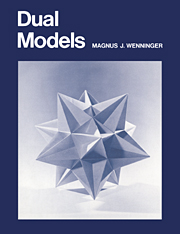Book contents
- Frontmatter
- Contents
- Foreword by John Skilling
- Preface
- Introduction
- I The five regular convex polyhedra and their duals
- II The thirteen semiregular convex polyhedra and their duals
- III Stellated forms of convex duals
- IV The duals of nonconvex uniform polyhedra
- V Some interesting polyhedral compounds
- Epilogue
- Appendix: Numerical data
- References
- List of polyhedra and dual models
Foreword by John Skilling
Published online by Cambridge University Press: 07 October 2009
- Frontmatter
- Contents
- Foreword by John Skilling
- Preface
- Introduction
- I The five regular convex polyhedra and their duals
- II The thirteen semiregular convex polyhedra and their duals
- III Stellated forms of convex duals
- IV The duals of nonconvex uniform polyhedra
- V Some interesting polyhedral compounds
- Epilogue
- Appendix: Numerical data
- References
- List of polyhedra and dual models
Summary
Mathematics is a remarkable subject. Quite simply, it is enormous fun. Usually in mathematics one is manipulating symbols on a page, or maybe these days on a computer screen, and it can be hard to appreciate the inherent beauty of the ideas one is playing with. The subject thus acquires a reputation for difficulty.
Occasionally, though, mathematics starts to describe clearly visible things, and its beauty becomes accessible to everybody. In this book, Father Magnus Wenninger takes us along one of these accessible branches of mathematics. One only has to read his work, or better still, meet the author himself, to realise that Magnus Wenninger is an enthusiast. His life's hobby is polyhedra – three-dimensional shapes governed by precise formal rules of construction. Two-dimensional shapes have their interest, but we are bombarded all our lives with two-dimensional pictures and symbols, and such patterns have lost some degree of novelty. Four-dimensional shapes are definitely difficult to visualise and appreciate.
Three dimensions make a happy compromise. A three-dimensional shape can be constructed as an actual model (though sometimes it takes some effort to do so!) and held in one's hand. Myself, I first became seriously interested in polyhedra for just this reason. One of my teachers at Cambridge, the late Jeff Miller, had contributed academically to the subject and also had an exquisite little set of intricately folded paper models.
- Type
- Chapter
- Information
- Dual Models , pp. ix - xPublisher: Cambridge University PressPrint publication year: 1983



